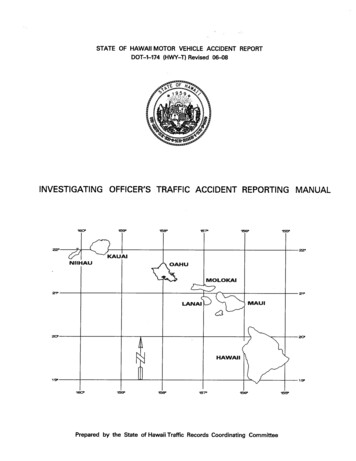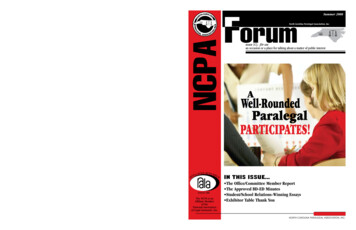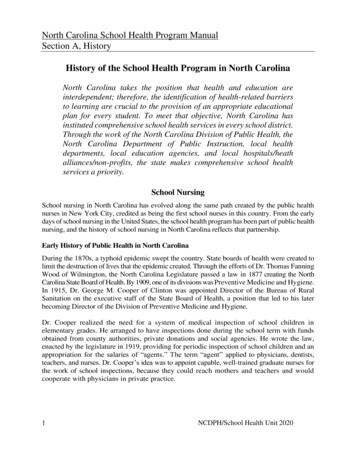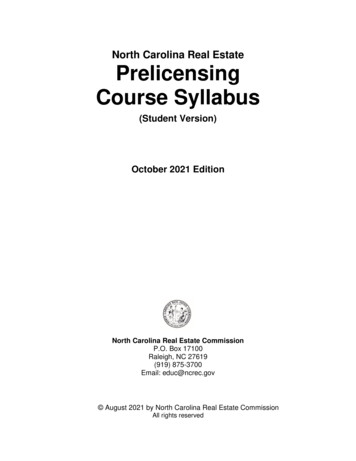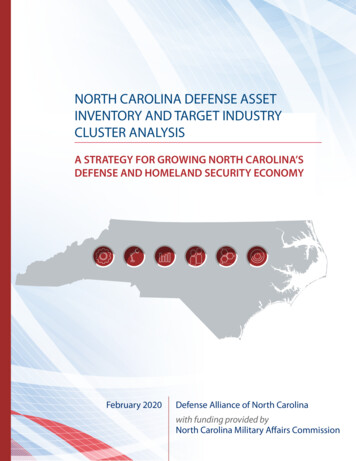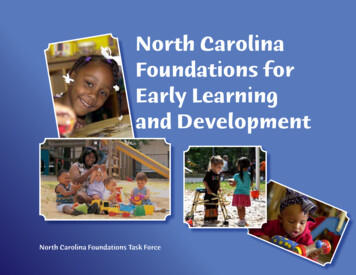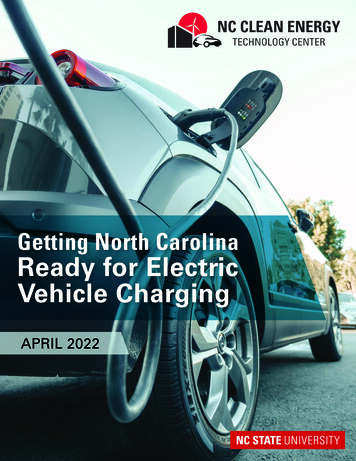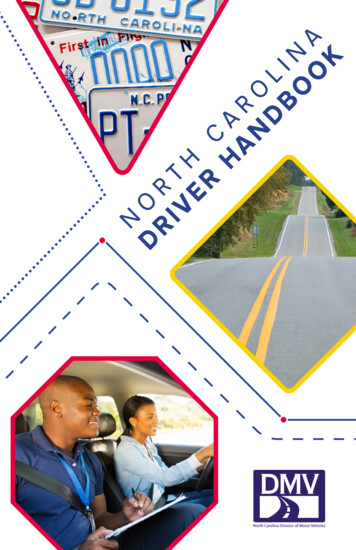
Transcription
DRORIV TE HR CH AA RN OD LB INOO AKN
1Dear North Carolina Driver:Earning your North Carolina driver license can help you travel to places ofuncommon beauty and diversity across our state. It also comes with the addedresponsibility of following the rules of the road to protect your fellow travelers.You’ll be joining more than 7.4 million licensed drivers throughout the state.When you are behind the wheel, we count on you to drive safely and look outfor others. By taking driving safety seriously, you can help reduce the 300,000crashes and more than 1,400 fatalities on our highways each year.This handbook was written to help prepare you for your driver licenseexamination. It offers valuable safe driving techniques to help keep you out ofharm’s way. If you need additional assistance, contact your nearest driver licenseoffice or go online to MyNCDMV.gov.Best wishes for safe driving,Roy CooperGovernorJ. Eric BoyetteSecretary of Transportation
23DMVdirectAccessautomated information by telephoneDMVdirectAccess is a convenient way to obtain information about driverlicenses and vehicle registration from the North Carolina Departmentof Transportation (NCDOT) Division of Motor Vehicles (DMV).Dial 919-715-7000 from a touch-tone telephone, and access information24 hours a day, seven days a week.Dear North Carolina Driver:DMVdirectAccess gives you the facts about:When you earn the privilege of driving in North Carolina, you are responsiblefor your life and the lives of others who travel our streets, roads and highways.It is up to each of us who drive a vehicle to protect the millions of citizenswho travel the same roads, whether by car, truck, motorcycle, bicycle or foot. Driver licenses, learner permits, motorcycle license endorsements,commercial driver licenses (CDLs) and special identification cards; Personalized information you should know about points against your driverlicense, your driving record and the status of your driver license; Medical and vision forms, exam cycles, records and hearings; Vehicle registration, duplicate titles, lost or stolen license plates, personalizedand vanity license plates and handicapped placards; and Liability insurance and more.Please use this driver handbook to learn and reinforce your safe and defensivedriving techniques. Make yourself familiar with the motor vehicle laws of ourstate and the ways you can improve your driving.As you prepare for the driver license examination, we invite you to contactDMV or your nearest driver license office for additional assistance. You canfind the locations of North Carolina driver license offices and other helpfulinformation on our website at MyNCDMV.gov.DMVdirectAccess also includes information about driver license and vehicleregistration taxes and fees. By entering your zip code, the system can give youthe location of a driver license or vehicle registration office in your area.Remember, always drive safely and obey the rules of the road. With your help,we can keep North Carolina’s roadways safe.DMV Information 919-715-7000Sincerely,Torre J. JessupCommissioner of Motor VehiclesOther DMV Telephone Listings:Traffic Records Section. . . . . . . . . . . . . . . . . . . . . . . . . . . . . 919-615-6131International Registration Plan (IRP) Section. . . . . . . . . . . . 919-615-6700Tag and Tax Together. . . . . . . . . . . . . . . . . . . . . . . . . . . . . . 919-814-1779Save time, go online! MyNCDMV.govAvailable Online Services: Pay Vehicle Property TaxesRenew Vehicle RegistrationOrder Duplicate Registration CardOrder Personalized PlatesSign up for Email NotificationsRenew Commercial Carrier Registration Renew Driver LicenseEstimate Vehicle Property TaxesOrder Driving RecordsView Your MyDMV AccountPay Insurance Lapse Penalties
4DMV on the Web5MyNCDMV.govThe NCDMV website focuses on providing North Carolina’s motorists withtimely and accurate information regarding NCDMV services and issues.The site answers your most frequently asked questions and includes up-todate directories of all DMV offices statewide. You will also find news aboutnew legislation and other requirements affecting North Carolina motorists.Publications and forms are also available online.Duplicate Driver License/DuplicateIdentification Card on the WebA duplicate driver license/duplicate identification card may be requested onlineat MyNCDMV.gov, provided that DMV has your last image on file and a validsocial security number or a document issued by the United States governmentindicating legal presence. A duplicate driver license/identification card may berequested for the following reasons: To replace a lost or stolen license/identification card; To change a residence and/or mailing address; or To replace a license/identification card that is defaced or damaged.A fee of 13 is charged and may be paid with any credit or debit card. Aduplicate license/identification card with the most recent photo available in ourcomputer system will be mailed to the customer.Online RenewalThe online driver license process is available to drivers every other time theyrenew their license, which is allowed up to six months before its expiration date.It is a process that should take just a few minutes, as a customer goes to theDMV online webpage, and uses the appropriate link under the Drivers section.Drivers must verify their identity, confirm they live at the address on the license,and have no vision problems that would hinder their driving skills, and that allthe statements being given are truthful. They also must have their current driverlicense number to complete the online form and a major credit card or debitcard to pay for the renewal. The new license will be mailed in 7-14 businessdays, and will be valid for 5 or 8 years, depending on the driver’s age.Customers cannot use the online system to obtain first time licenses or IDcards.This also applies to first time REAL ID issuances. Online service is alsonot available if a driver has a restriction other than corrective lenses on theirlicense, is in the medical review program, is trying to renew a commercial driverlicense or a state ID card, or has an expired suspended or revoked license. Thosecustomers must still complete those processes at a DMV license office.Transportation AlternativesFor many North Carolinians, operating a vehicle may be too costly,inconvenient or dangerous. The North Carolina Department of Transportationwants you to know there are many transportation alternatives to driving. In oursociety, we often overlook our options to walk, ride a bicycle, carpool and usepublic transportation.Public transportation could be your best alternative to driving. Some formof public transportation is available in most areas of the state. In the largermetropolitan areas, there are bus systems that operate on regular routes. Smallerrural areas may provide coordinated van services for citizens. In either case,public transportation is available and equipped to accommodate personswith disabilities.To learn more about public transportation options in your area, call:N.C. Department of Transportation Public Transportation Division919-707-4670.
6Table of ContentsTable of ContentsChapter 1 — Your License78General Driving.44Office Hours.8Learner Permit.8Motorcycle Learner Permit.8Test Requirements for an Original Driver License.9Basic Driving Skills and Rules.50Vision, Traffic Signs, Knowledge Test, Driving Skills, Health Requirements,Skills observed and graded during the on-the-road driving test, Three-PointTurnaboutTypes of Licenses, Permits and Restrictions.10Regular Licenses, Commercial Licenses, Endorsements, Graduated Licensing—Licensing for Drivers 15–18, The Provisional Licensee,Thinking of Dropping Out?, Lose Control/Lose Your License, RestrictionsApplicants under Age 18 Applying for a Driver License or Learner Permit,Proof of Identity and Age, Social Security Number Requirement, Proof of Residencyin North Carolina, Proof of Legal Presence in the U.S., Deferred Action forChildhood Arrivals (DACA), Proof of Insurance, No Fee ID CardsRenewal, Renewal By Mail (Temporary License), Military, Veterans, Duration andRenewal of License, Duplicate, Address Changes, Name ChangesIdentification Cards. 27Schedule of Fees. 27Other Services. 28Voter Registration, Organ Donor Program, Selective Service System Registration,Requirements for Sex Offender Registration Program29DWI Laws, Blood Alcohol Concentration RestrictionsAlcohol and the Young Driver .3032Points. 32Driver License Points, Insurance PointsSuspensions.34Out-of-State Conviction, Failure to Appear and/or to Pay a Fine,Provisional Licensee (under age 18)Driver License Restoration. 3738Driver Safety.38Driver Condition, Drowsy Driving, Distracted Driving,Protecting Yourself and Your Passengers.41Seat Belts, Child Safety, Child Seats, Booster Seats and Seat Belts for Children,Children and Air Bags, Child Safety Points, Adult Safety Points, North CarolinaMotorcycle Safety Helmet Law, Law on Transporting Children in the Back of aPick-up Truck, Weather RiskHazardous Driving.68Work Zones, Night Driving, Sun Glare, Rain, Hydroplaning, Driving in FloodConditions, Fog, Snow and IceBrake Failure, Wet Brakes, Gas Pedal Sticks, Blowouts, Breakdowns, UnusualEmergencies, SkidsCrashes. 74Chapter 5 — Signals, Signs and Pavement Markings76Traffic Signals. 76Flashing Signals, Left-Turn Traffic Signal Heads, Ramp Meter Traffic Signals,Hybrid BeaconsTraffic Signs. 79Regulatory, Warning, Guide/InformationalPavement Markings.84Traffic Officers.84Chapter 6 — Sharing the RoadDriving While Impaired. 29Chapter 4 — Your DrivingDefensive Driving.66Emergencies. 72Liability Insurance Requirement.21North Carolina's REAL ID. 22Moving to North Carolina. 23North Carolina's Driver License and Identification Card. 23Renewal and Duplicate Licenses. 24Chapter 3 — Your Driving PrivilegeDriving on Your Side of the Road, Adjusting Your Speed to Driving Conditions,Rounding a Curve, Turning, Following, Changing Lanes, Passing, Backing,Parking, Special Driving Situations, Single Point Interchange, Traffic Circles andRoundabouts,Vehicle EquipmentScanning, Communicating, Hand SignalsRequired Documents.15Chapter 2 — Alcohol and the LawThe Driver and Pedestrian, Protecting Motorcyclists from Unsafe Movements,School Buses, Emergency and Law Enforcement Vehicles, What Motorists Should DoWhen Stopped By Law Enforcement, What Motorists Should Do When Stopped ByLaw Enforcement, Safe Driving Around Farm Equipment, Funeral Processions85Bicycles. 85Pass with Care, Go with the Flow, Be VisibleYou as a Pedestrian. 87Trucks and Other Vehicles. 87No-ZonesRecreational Vehicles and Trailers.88Motorcycles and Mopeds.88Keeping the Road Litter-Free.91Adopt-A-Highway ProgramChapter 7 — How DMV Serves You92DMV Mobile Service Centers. 92Driver Records. 92FeesVehicle Registration.93Insurance and Financial Responsibility, Vehicle Registration Renewal,Transfer of a Motor Vehicle, Transfer of License Plates, Replacement of Lost Titleor Registration CardTag & Tax Together.96How do I pay?Vehicle Emissions & Safety Inspection. 97Exemptions, Window Tinting
8Chapter 1 — Your LicenseChapter 1Your LicenseDriving is a legal privilege and responsibility. It is against the law to drive amotor vehicle on streets and highways without a valid driver license. It is alsoillegal to sit in the driver’s seat of a motor vehicle while the engine is running orto steer a motor vehicle while it is being pushed or towed by another vehicle ifyou do not have a valid driver license.Office HoursDriver license examiners throughout the state are trained to test fairly and togive prompt and courteous service. Most offices offer services from 8:00 a.m.to 5:00 p.m. In larger cities and towns, the offices are open Monday throughFriday, and some are open Saturday mornings. Offices in smaller towns mayonly be open for certain days each week. Appointments for driver licenseexaminations can be made by contacting your local driver license office. For anup to date list of office hours and locations, please visit MyNCDMV.gov.For an original driver license of any type, youmay be tested on: Vision; Traffic signs; and Knowledge of motor vehicle laws; Driving skill (on-road test).Learner Permit Learner permits are available to persons age 18 and older. A learner permit authorizes the permit holder to drive a specified type orclass of motor vehicle while in possession of the permit. The permit holder must, while operating a motor vehicle over the highways,be accompanied by a person who is licensed to operate the motor vehiclebeing driven and is seated beside the permit holder. Required testing includes vision, traffic signs, and knowledge ofmotor vehicle laws.Motorcycle Learner Permit If an applicant is at least 16 years old but less than 18 years old, the applicantmust possess a full provisional license issued by the division. Parent orguardian’s signature is required. If an applicant is 18 years old or older, the applicant must possess a licenseissued by the division. The motorcycle learner permit authorizes a person to operate a motorcyclewithout passengers. If an applicant is less than 18 years old, the applicant must successfullycomplete the Motorcycle Safety Foundation Basic Rider Course or the NorthCarolina Motorcycle Safety Education Program Basic Rider Course. TABLE OF CONTENTSChapter 1 — Your License9 The motorcycle learner permit is valid for 12 months and may berenewed for one additional six-month period. Required testing includes vision, traffic signs, and themotorcycle knowledge test.Each driver license test must be passed separately. Applicants for a CDL ClassA, B or C license should study the required chapters of the CDL Handbook.Applicants for a motorcycle endorsement or motorcycle learner permit shouldstudy the Motorcycle Handbook. The CDL Handbook is available from the FederalMotor Carrier Safety Administration. You may also obtain the CDL, Regular andMotorcycle handbooks on the DMV website and at the local driver license offices.Visit the DMV website at MyNCDMV.gov.Test Requirementsfor an Original Driver LicenseVisionWhether you are applying for a learner permit, an original license or a renewallicense in person, your vision must be checked to see that you meet certainstandards. If you need corrective lenses to bring your vision up to the requiredstandards, you must wear the lenses at all times while driving and your license willindicate a restriction that you must wear corrective lenses. The penalty for drivingwithout the proper corrective lenses is the same as driving without a license.Traffic SignsAll the information on the traffic signs test is in this handbook. To pass thesigns test, you must identify the traffic signs by color and shape and explainwhat each means.Knowledge TestThe knowledge test is about traffic laws and safe driving practices. Audio testsare available, upon request, for those who have difficulty reading.Driving SkillsThe driving test is an on-the-road demonstration of your driving ability. You mustperform this test after you have passed all the other tests. The first time you applyfor a license, you must take the driving test. You might also have to take it to renewyour license. It is not required for a learner permit.During the on-the-road test, you will be given an opportunity to perform basicdriving patterns and to show your ability to drive safely with traffic.Health RequirementsIndividuals may not be licensed if they suffer from a mental or physicalcondition that might keep them from driving safely. A person with a disabilitymay be issued a restricted license provided the condition does not keep themfrom driving safely. TABLE OF CONTENTS
10Chapter 1 — Your LicenseSkills observed and graded during theon-the-road driving test: Approaches to intersections, stop signs and traffic signals; Quick stops — stopping as quickly and safely as possiblewhen told to do so; Backing; Stopping, starting and parking; Use of the clutch (in vehicles with standard transmissions); Turn signals and use of the horn; Turning; Use of lanes; Following another vehicle; Passing and being passed; Yielding the right of way to pedestrians and other vehicles; Driving posture; and Three-point turnabout.Applicants for an original driver license must take the on-theroad driving test; however, there are some cases when theon-the-road test may not be required.Types of Licenses, Permitsand RestrictionsChapter 1 — Your LicenseTIPThree-PointTurnabout(1) Start fromthe extreme rightside of the road.Look for othertraffic and if clear,give a left signaland proceedforward slowlywhile turning thesteering wheelto the left. Stopwithin severalinches of the leftcurb or edge of thestreet.(2) Then proceedbackward slowlywhile turning thesteering wheel tothe right. Stopwithin severalinches of the rightcurb or edge of thestreet.(3) Proceedforward slowlywhile turning thesteering wheelto the left. Thisshould completeyour turnabout.North Carolina has a regular driver license and acommercial driver license (CDL). The type of vehicle youwill operate determines the class of driver license you must have and the typevehicle in which you must take the driving skills test. The driving skills testmust be performed in a vehicle representative of the class license desired.Regular LicensesClass A: Required to operate a combination of vehicles that is exempt fromCDL requirements when the towed unit has a gross vehicle weight rating(GVWR) of 10,001 pounds or more.Class B: Required to operate any single vehicle that is exempt from CDLrequirements with a GVWR of 26,001 pounds or more, and any such vehicletowing a vehicle with a GVWR not in excess of 10,000 pounds.Class C: Required to operate any noncommercial single vehicle with aGVWR of less than 26,001 pounds; and a vehicle towing a vehicle which hasa combined GVWR of less than 26,001 pounds operated by a driver 18 yearsold or older. Most drivers need only a Regular Class C license to operatepersonal automobiles and small trucks. TABLE OF CONTENTS11Commercial Driver License (CDL)A CDL is required for drivers, paid or volunteer, who drive the following typesof vehicles that are designed or used to transport passengers or property:Class A Motor Vehicle: A vehicle that has a combined GVWR of at least26,001 pounds and includes as part of the combination a towed unit that has aGVWR of at least 10,001 pounds.Class B Motor Vehicle: A single motor vehicle that has a GVWR of at least 26,001 pounds. A combination of motor vehicles that includes as part of the combination atowing unit that has a GVWR of at least 26,001 pounds and a towed unitthat has a GVWR of less than 10,001 pounds.Class C Motor Vehicle: A single or combination of motor vehicles notincluded in Class A or B but meets any of the following descriptions: Is designed to transport 16 or more passengers, including the driver; and Is transporting hazardous materials and is required to be placarded.You do not need a CDL to drive recreational vehicles, military equipment,fire and/or emergency equipment or certain farm vehicles. However, a regularlicense of the appropriate class is required at all times.A volunteer member of a fire department, rescue or emergency service (EMS) inthe performance of duty may operate a Class A, B or C fire-fighting, rescue orEMS vehicle, or combination of these vehicles while holding either a “Regular”A, B or C License.A special CDL endorsement is required to haul hazardous materials, transportpassengers, drive school buses and school activity buses, pull double trailers ordrive tank vehicles. Additional information is in the CDL Handbook.EndorsementsMotorcycleA person must have a regular or commercial license with a motorcycleendorsement or a motorcycle learner permit before being entitled to operate amotorcycle on public roads.School Bus/School Activity BusThe driver of a school bus must be at least 18 years of age, have at least sixmonths driving experience and hold either a Class B or Class C CDL withan “S” (school bus) and a “P” (passenger) endorsement along with a SchoolBus Driver’s Certificate. To obtain a School Bus Driver’s Certificate, a personmust be specially trained and pass an examination administered by a DriverEducation Program Specialist which demonstrates the fitness and competencyrequired to operate the bus. The requirements for a driver of a public schoolactivity bus are the same. The requirements for the driver of a school activitybus are the same except a School Bus Driver’s Certificate is not required.NOTE: Pursuant to G.S. 20-37.14A, the Division shall not issue or renew acommercial driver license reflecting a “P” or “S” endorsement to anyone required toregister under sex offender and public protection registration programs. TABLE OF CONTENTS
12Chapter 1 — Your LicenseGraduated Licensing—Licensing for Drivers 15–18Limited Learner PermitIf you are at least 15 years of age and have completed an approved drivereducation course that meets North Carolina requirements and can present aDriving Eligibility Certificate (issued by the public school system), or a highschool diploma or its equivalent, you may apply for a Level One LimitedLearner Permit to operate vehicles requiring a Class C License. You must be at least 15 years old but less than 18 years old and reside inNorth Carolina. You must present a certificate showing you have passed an approved drivereducation course consisting of at least 30 hours classroom instruction and sixhours behind-the wheel instruction that meets North Carolina requirementsbefore you can take the test for a learner permit. You must pass written, sign and vision tests. During the first six months, a level one permit authorizes you to drivebetween the hours of 5 a.m. and 9 p.m., while accompanied by yoursupervising driver. Six months from level one issuance, you are eligible to drive anytime with asupervising driver. You must hold this permit for 12 months prior to applying for a LimitedProvisional License. You will be given a Driving Log to be completed detailing a minimum of60 hours of operation. Daytime or daylight driving can be performed fromsunrise to sunset and as long as daylight exists. Nighttime or night drivingcan be performed after sunset and within the hours that sunlight or daylightdoes not exist. All passengers must be restrained by seat belt or child safety seat. No one except the driver and the supervising driver are allowed in the front seat. You are not permitted to use a cell phone or other additional technologyassociated with a cell phone while operating a motor vehicle on a public streetor highway or public vehicular area. Exception: You can use it to call thefollowing regarding an emergency situation: an emergency response operator;a hospital, physician’s office or a health clinic; a public or privately ownedambulance company or service; a fire department; a law enforcement agency;your parent, legal guardian or spouse.NOTE: Before graduating to level two, you must have no convictions of motorvehicle moving violations, seat belt or cell phone infractions within the precedingsix months.SUPERVISING DRIVER: A supervising driver must be a parent, grandparentor guardian of the permit/license holder, or a responsible person approved by theparent or guardian. A supervising driver must hold a valid driver license and musthave been licensed for at least five years. TABLE OF CONTENTSChapter 1 — Your License13Level Two Limited Provisional License Drivers must be at least 16 years old, but less than 18. You may drive without supervision from 5 a.m. until 9 p.m. and at anytime when driving directly to or from work or any volunteer fire, rescue oremergency medical service, if you are a member. You must hold this license at least six months prior to applying for a FullProvisional License. You will be given a Driving Log to be completed detailing a minimum of12 hours of operation. At least six hours must occur during nighttime hours.Daytime or daylight driving can be performed from sunrise to sunset andas long as daylight exists. Nighttime or night driving can be performed aftersunset and within the hours that sunlight or daylight does not exist. The logmust be signed by the supervising driver and submitted to the Division at thetime of application for the Full Provisional License. All passengers must be restrained by seat belt or child safety seat. Supervising driver must be seated beside the driver. The number of passengers allowed in the vehicle under the age of 21 isrestricted to ONE when the driver of the vehicle is the holder of a level II, ORif all passengers under the age of 21 are members of the driver’s immediatefamily or members of the same household as the driver, there is no “under 21”limit. If the supervising driver is in the car, this restriction does not apply. You are not permitted to use a cell phone or other additional technologyassociated with a cell phone while operating a motor vehicle on a public streetor highway or public vehicular area. Exception: You can use it to call thefollowing regarding an emergency situation: an emergency response operator;a hospital, physician’s office, or a health clinic; a public or privately ownedambulance company or service; a fire department; a law enforcement agency;your parent, legal guardian or spouse.NOTE: Before graduating to level three, you must have no convictions of motorvehicle moving violations, seat belt or cell phone infractions within the precedingsix months.SUPERVISING DRIVER: A supervising driver must be a parent, grandparent orguardian of the permit/license holder, or a responsible person approved by the parentor guardian. A supervising driver must hold a valid driver license and must havebeen licensed for at least five years.Level Three Full Provisional License The restrictions on level one and level two concerning time ofdriving, supervision and passenger limitations do not apply to aFull Provisional License. If you are under the age of 18, you are not permitted to use a cell phone orother additional technology associated w
cards.This also applies to first time REAL ID issuances. Online service is also not available if a driver has a restriction other than corrective lenses on their license, is in the medical review program, is trying to renew a commercial driver license or a state ID card, or has an expired suspended or revoked license. Those

